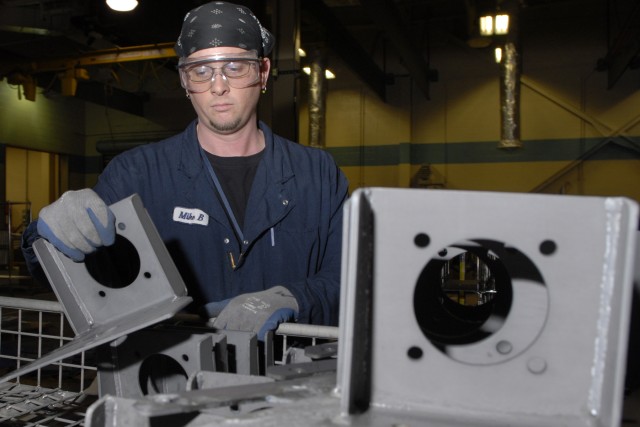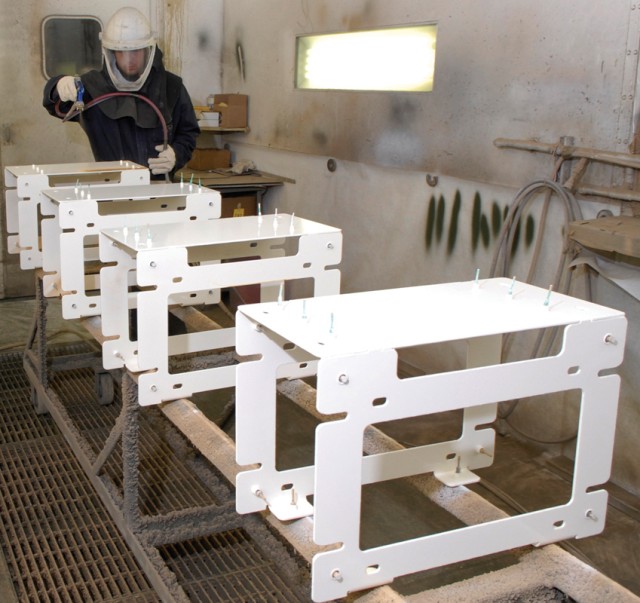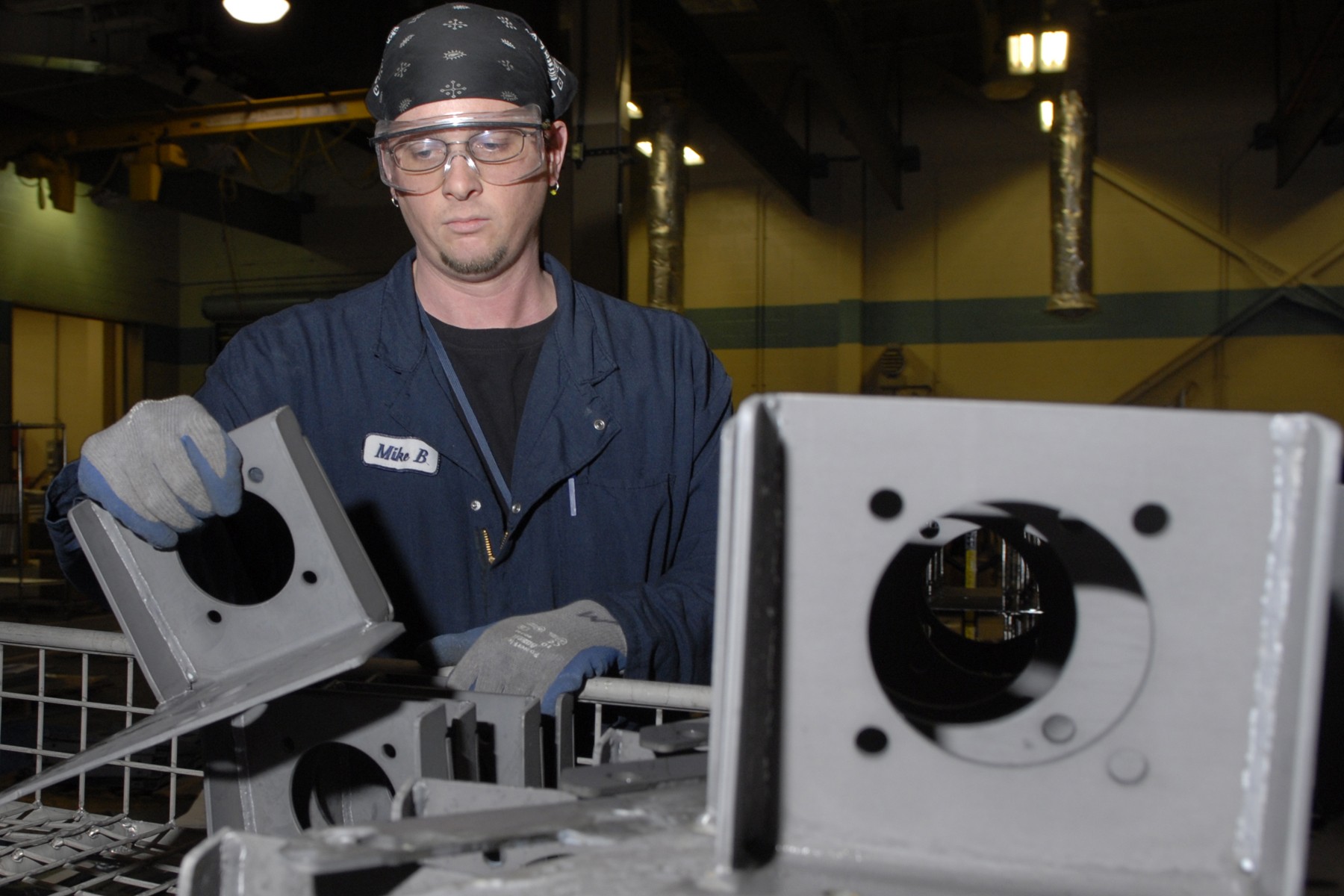<a href=" http://www.tobyhanna.army.mil/" target="_blank">TOBYHANNA ARMY DEPOT</a>, Pa. - Tobyhanna is providing an armored layer of protection for critical improvised explosive device (IED) jamming systems used in Operation Enduring Freedom (OEF).
Employees are fabricating and assembling more than 1,000 installation kits for an armored box as part of a multi-million dollar Program Manager (PM) Counter Radio Control Improvised Explosive Device Electronic Warfare (CREW) surge requirement to upgrade three vehicles in the Army's rolling stock: Heavy Expanded Mobility Tactical Truck (HEMTT) A4 and Family of Medium Tactical Vehicles (FMTV) Long Term Armor Strategy (LTAS) and Palletized Load System (PLS) V2/V3.
The installation kits contain the items to build the armored box and include antennas, brackets, and mounting and cable assemblies.
"The vehicles we support require the CREW systems to be positioned outside of the cab, leaving them unprotected," said Tom Sweeney, logistics management specialist. "The function of our kits is to provide protection [armor boxes] to the systems and to mount specific antennas. In some cases we also supply brackets, platforms and racks to mount the armor boxes." Sweeney works in the Production Management Directorate's Manufacturing and Systems and Support Branch.
The CREW system was developed to provide U.S. forces life-saving protection against a wide range of low- and high-power IED threats. The field-deployable, single-unit system uses state-of-the-art jamming technology to counter these threats.
The OEF surge is being completed in three phases, called Force Packages, which consist of quantities of vehicles with specific load dates. The first Force Package was completed in February, the second in March and the third is scheduled for completion in August. On average each kit contains 15-20 parts.
"We worked with PM CREW to get the schedules for each Force Package and have been working to
continue to ship ahead of schedule so the installations can be completed before the vehicles are loaded for shipment to theater," Sweeney said.
PM CREW's product manager describes the partnership between the depot and his organization as "outstanding." "The teaming between the two entities is great," said Lt. Col. Bruce Ryba, Product Manager CREW. "The nature of CREW work is unpredictable and we face new challenges every day. As always, Tobyhanna stepped up to the plate to support the warfighter."
Items are fabricated in collaborative effort by Production Engineering and Systems Integration and directorate personnel. Engineers worked with technicians in sheet metal, machining and welding shops to build the parts. In addition, cables, switch boxes and fan assemblies are fabricated in the electrical shops, explained Jack Andrejko, mechanical engineering technician, Manufacturing Engineering Branch.
"Every shop we work with realizes the importance of this mission and were more than ready to help," Andrejko said.
Sweeney agreed. "All the shops have played a major role in working with Production Management and the customer to get the kits out the door," he said. "We wouldn't be where we are today without them."
The Component Refinishing Branch performs a variety of functions depending on the particular PM CREW asset. For instance, some of the aluminum parts are cleaned in an ultrasonic tank prior to welding, and some of the armor plates and assemblies are sandblasted prior to plating operations, according to Christopher Paulic, branch chief. In addition, Paulic explained that his team sometimes prepares items before and after painting operations.
"All three of my shifts should be commended for their efforts," Paulic said. "Everyone answered the call with daily and weekend overtime to support the PM CREW surge effort."
Mechanical engineers, Jason Klimczak and Tim Knabel joined other shop technicians from Tobyhanna and travelled to Bluegrass Station, Ky., where the kits were being installed, to show the customer how to install the kits. The team also provided instructions and installation procedures.
Material planner Peggy O'Hara identified lead times and provided expedited deliveries to meet schedules.
"Our area is shipping," said Lee Ann Lyons, logistics analyst. "We have a team of four people who receive and ship all the CREW surge workload. We have been able to receive equipment from the shop and ship the same day to assist in meeting the customer requirements. We can average a few hundred pallets a week."
One production controller referred to the surge effort as an "adrenaline pumper." Rose Brown works alongside other controllers to make sure everyone has everything they need to complete the job.
"When you stop and think of what you're doing for the warfighter, it really gives you a good feeling of accomplishment to know you played a part in helping them accomplish their mission."
Tobyhanna Army Depot is the Defense Department's largest center for the repair, overhaul and fabrication of a wide variety of electronics systems and components, from tactical field radios to the ground terminals for the defense satellite communications network. Tobyhanna's missions support all branches of the Armed Forces.
About 5,600 personnel are employed at Tobyhanna, which is located in the Pocono Mountains of northeastern Pennsylvania.
Tobyhanna Army Depot is part of the U.S. Army CECOM Life Cycle Management Command. Headquartered at Fort Monmouth, N.J., the command's mission is to research, develop, acquire, field and sustain communications, command, control computer, intelligence, electronic warfare and sensors capabilities for the Armed Forces.




Social Sharing